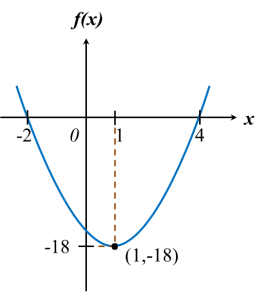5.2a Laws of Logarithms
5.2a Laws of Logarithms
5.2 Logarithms
5.1 Indices and Laws of Indices (Part 2)
5.1 Indices and Laws of Indices (Part 2)
(C) Fractional Indices
Example 1:
Find the value of the followings:Solution:
Example 2:
Find the value of the followings:
Solution:
(D) Laws of Indices
Indices and Laws of Indices (Part 1)
Positive Integral Indices
When a real number a is multiplied by itself n times, the result is the nth power of a.
Example: 5×5×5×5 = 54 (5 to the power of 4)
In general, if a is any real number and n is a positive integer, then
The integer n is called the index or exponent and a is the base.
5.1 Indices and Laws of Indices (Part 1)
(A) Zero IndicesThe zero index of any number is equal to one.
a 0 = 1, where a ≠ 0 |
Example 1:
Find the value of the followings:
(a) 2500
(b) 0.5130
Solution:
(a) 2500 = 1
(b) 0.5130 = 1
(B) Negative Integral Indices
Example 2:
Find the value of the followings:
(a) 102 -1
(b) –6 -3
Solution:
Quadratic Functions, SPM Practice (Long Questions)
Question 3:
Given that the quadratic function f(x) = 2x2 – px + p has a minimum value of –18 at x = 1.
(a) Find the values of p and q.
(b) With the value of p and q found in (a), find the values of x, where graph f(x) cuts the x-axis.
(c) Hence, sketch the graph of f(x).
Solution:
(a)
(b)
(c)

Given that the quadratic function f(x) = 2x2 – px + p has a minimum value of –18 at x = 1.
(a) Find the values of p and q.
(b) With the value of p and q found in (a), find the values of x, where graph f(x) cuts the x-axis.
(c) Hence, sketch the graph of f(x).
Solution:
(a)
(b)
(c)

Quadratic Functions, SPM Practice (Short Questions)
Question 3:
The straight line y = 5x – 1 does not intersect with the curve y = 2x2 + x + h.
Find the range of values of h.
Solution:
The straight line y = 5x – 1 does not intersect with the curve y = 2x2 + x + h.
Find the range of values of h.
Solution:
Question 4:
Find the maximum value of the function 5 – x – 2x2 , and the corresponding value of x.
Solution:
Find the maximum value of the function 5 – x – 2x2 , and the corresponding value of x.
Solution:
Quadratic Functions, SPM Practice (Short Questions)
Question 1:
Find the minimum value of the function f (x) = 2x2 + 6x + 5. State the value of xthat makes f (x) a minimum value.
Solution:
By completing the square for f (x) in the form of f (x) = a(x + p)2 + q to find the minimum value of f (x).
Since a = 2 > 0,
Therefore f (x) has a minimum value when . The minimum value of f (x) = ½.
Question 2:
The quadratic function f (x) = –x2 + 4x + k2, where k is a constant, has a maximum value of 8.
Find the possible values of k.
Solution:
f (x) = –x2 + 4x + k2
f (x) = –(x2 – 4x) + k2 ← [completing the square for f (x) in
the form of f (x) = a(x + p)2+ q]
f (x) = –[x2 – 4x + (–2)2 – (–2)2] + k2
f (x) = –[(x – 2)2 – 4] + k2
f (x) = –(x – 2)2 + 4 + k2
Given the maximum value is 8.
Therefore, 4 + k2 = 8
k2 = 4
k = ±2
3.4 Quadratic Inequalities (Part 2)
(C) Linear Inequality
Example 1
(a) Given , find the range of values of x for which y > 9 .
(b) Given , find the range of values of x for which y < 4 .


Example 1
(a) Given , find the range of values of x for which y > 9 .
(b) Given , find the range of values of x for which y < 4 .


3.2 Maximum and Minimum Value of Quadratic Functions
Maximum and Minimum Point
- A quadratic functions can be expressed in the form by the method of completing the square.
- The minimum/maximum point can be determined from the equation in this form .
Minimum Point
- The quadratic function f(x) has a minimum value if a is positive.
- The quadratic function f(x) has a minimum value when (x + p) = 0
- The minimum value is equal to q.
- Hence the minimum point is (-p, q)
Maximum Point
- The quadratic function f(x) has a maximum value if a is negative.
- The quadratic function f(x) has a maximum value when (x + p) = 0
- The maximum value is equal to q.
- Hence the maximum point is (-p, q)
Example
Find the maximum or minimum point of the following quadratic equations
a.
b.
Answer:
(a)
(b)
Find the maximum or minimum point of the following quadratic equations
a.
b.
Answer:
(a)
(b)





